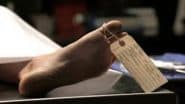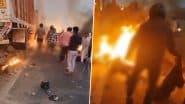New Delhi, Feb 24 (PTI) The Uttar Pradesh government has informed the Supreme Court that the disputed "private well" near the Mughal-era Jama Masjid mosque in Sambhal was situated on public land.
A status report was filed before a bench comprising Chief Justice Sanjiv Khanna and Justice Sanjay Kumar following a January 10 direction of the top court.
"Petitioners are attempting to create private rights over a public well. The subject well is part of the 19 wells that are being revived by the district administration for inter alia, rainwater harvesting, water recharge and use by all communities," the report said.
The report said the well, locally known as "dharani varah koop", was situated near and not inside the disputed religious site, and had no connection with the mosque.
"Even the disputed religious site is itself situated on public land. It is submitted that the well is a public well and is not situated anywhere inside the mosque/disputed religious site. In fact, there is no access to the subject well from inside the mosque," it added.
The state administration formed a three-member committee comprising the SDM Sambhal, area officer, Sambhal and the executive officer, municipal council, Sambhal, to examine the status of the well in question.
The state government said the petitioner failed to disclose there was a well within the boundary walls of the mosque known locally as "yagna koop".
The committee, in a spot inspection, found that the well was situated outside the mosque boundary wall, the report said.
"The petitioner has annexed misleading photographs attempting to show that the subject well is located inside its premises..It was also found during the inspection that this well was in use since time immemorial by persons of all communities. However, now it has no water and it was further found that after the communal riots of 1978, a police chowki was built on top of one part of the well. The other part continued to be in use even post 1978. It was further found that sometime in 2012, the subject well was covered and at present, there is no water in the well," it added.
The report said the state was committed to ensuring peace and harmony in the region and any restraint on the use of such public wells by the community at large may not help in achieving that goal.
Ordering a status quo, the top court on January 10 asked the Uttar Pradesh authorities, the Archaeological Survey of India (ASI) and others not to take steps over a "private well" near the Mughal-era Jama Masjid mosque in Sambhal.
Considering a plea of the management committee of Shahi Jama Masjid, Sambhal, the court issued notices to the Centre, the director general of the ASI, Sambhal district magistrate and other private individuals from the Hindu side led by Hari Shankar Jain.
The mosque committee said the Sambhal district administration was conducting a purported drive to revive old temples and wells in the city with reports indicating at least 32 old unused temples were revived and 19 wells were identified for public use and prayers.
The plea therefore sought a direction to the Sambhal district magistrate to ensure a status quo over the private well located near the mosque entrance aside from any future action without the Supreme Court's permission.
While a covered half of the well was said to be inside the mosque, the other half protruded outside on a curved platform.
Water from the well, situated at the junction of three narrow lanes leading to the main entrance of the mosque, was being used by the mosque, the plea said.
The mosque committee moved the Supreme Court on November 28, challenging the November 19 order of the district court directing the survey of the Mughal-era mosque and sought an ex-parte stay on the operation of the November 19, last year order passed by the civil judge.
On November 24, last year protesters gathered near the mosque and clashed with the security personnel, leading to stone pelting and arson, leaving four dead and several injured.
(This is an unedited and auto-generated story from Syndicated News feed, LatestLY Staff may not have modified or edited the content body)













 Quickly
Quickly
















